
Bananas
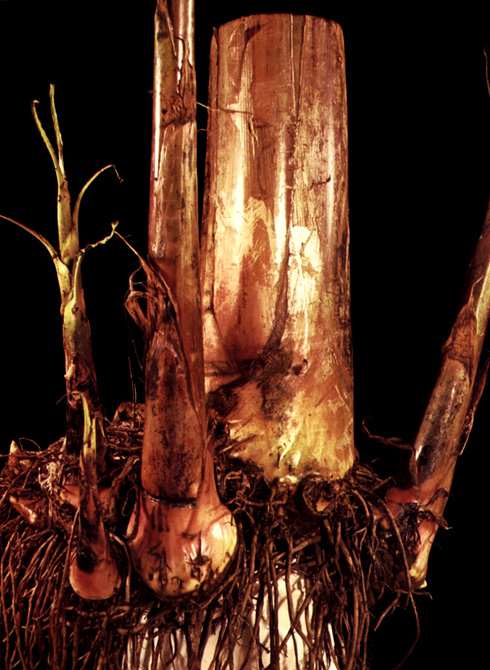 Bananas
are treelike herbs. Species of bananas are native to Southeast Asia
but are now grown extensively in all tropical countries for their
fruit, fiber, or foliage. The banana is a large plant with a
perennial root, or rhizome, from which the plant is perpetuated by
Bananas
are treelike herbs. Species of bananas are native to Southeast Asia
but are now grown extensively in all tropical countries for their
fruit, fiber, or foliage. The banana is a large plant with a
perennial root, or rhizome, from which the plant is perpetuated by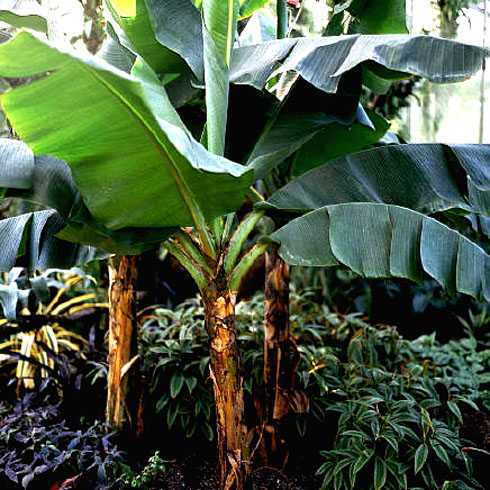 sprouts or suckers. In the tropics the stems are annual, that is,
they die after perfecting the fruit, and new stems are developed from
buds in the rootstock. These stems, or buds, are the common means of
propagating and making new plantations, and the growth is so rapid
that the fruit is usually ripe within ten months after the offsets
are planted. When fully grown the stem attains a height of 3 to 12 m
(10 to 40 ft) and is topped by a crown of large oval leaves up to 3 m
(10 ft) long, with a strong fleshy footstalk and midrib.
sprouts or suckers. In the tropics the stems are annual, that is,
they die after perfecting the fruit, and new stems are developed from
buds in the rootstock. These stems, or buds, are the common means of
propagating and making new plantations, and the growth is so rapid
that the fruit is usually ripe within ten months after the offsets
are planted. When fully grown the stem attains a height of 3 to 12 m
(10 to 40 ft) and is topped by a crown of large oval leaves up to 3 m
(10 ft) long, with a strong fleshy footstalk and midrib. 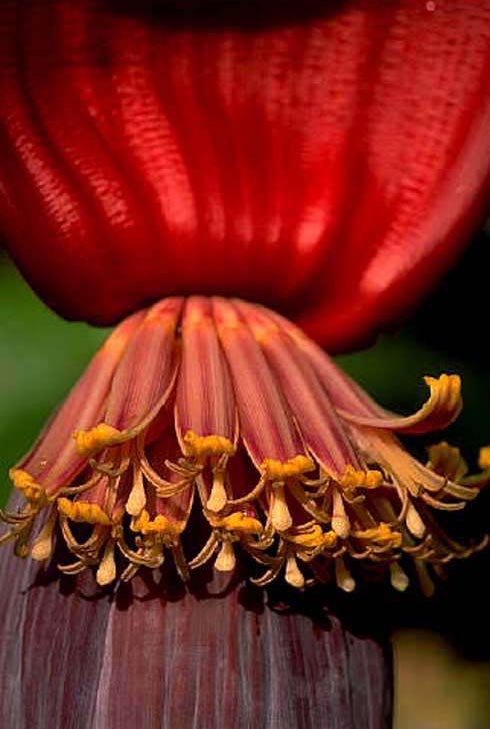 The
flowers spring in great spikes from the center of the crown of
leaves and are arranged in whorl-like clusters along the spike; the
female flowers occupy the base of the spike, and the male the apex.
The fruits vary in length from about 10 to 30 cm (4 to 12 in). The
average weight of a bunch is about 11 kg (about 25 lb), but
individual bunches often exceed 18 kg (40 lb). A stalk bears only
once, dies down, and is replaced by sprouts, two or three of which
are allowed to bear fruit.
The
flowers spring in great spikes from the center of the crown of
leaves and are arranged in whorl-like clusters along the spike; the
female flowers occupy the base of the spike, and the male the apex.
The fruits vary in length from about 10 to 30 cm (4 to 12 in). The
average weight of a bunch is about 11 kg (about 25 lb), but
individual bunches often exceed 18 kg (40 lb). A stalk bears only
once, dies down, and is replaced by sprouts, two or three of which
are allowed to bear fruit.
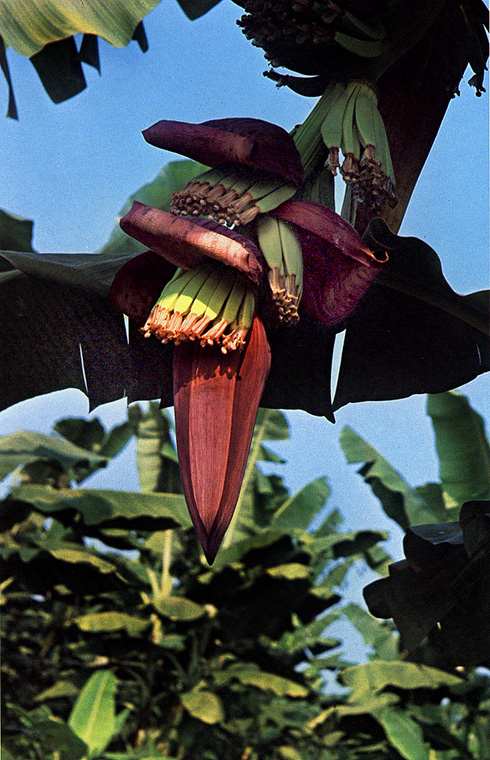 The
fruit of the plantain, or cooking banana, is larger, coarser, and
less sweet than the kinds that are generally eaten raw. The edible
part of the banana contains, on the average, 75 percent water, 21
percent carbohydrate, and about 1 percent each of fat, protein,
fiber, and ash. Other parts of the plant abound in fiber, which can
be used in the manufacture of paper and cordage. One species is the
source of Manila hemp.
The
fruit of the plantain, or cooking banana, is larger, coarser, and
less sweet than the kinds that are generally eaten raw. The edible
part of the banana contains, on the average, 75 percent water, 21
percent carbohydrate, and about 1 percent each of fat, protein,
fiber, and ash. Other parts of the plant abound in fiber, which can
be used in the manufacture of paper and cordage. One species is the
source of Manila hemp.
Half of the world's banana crops are grown in Africa, and much of the produce is used locally. The leading banana-export regions are Central America and northern South America.
Microsoft ® Encarta ® Encyclopedia 2002. © 1993-2001 Microsoft Corporation. All rights reserved.
Banana Facts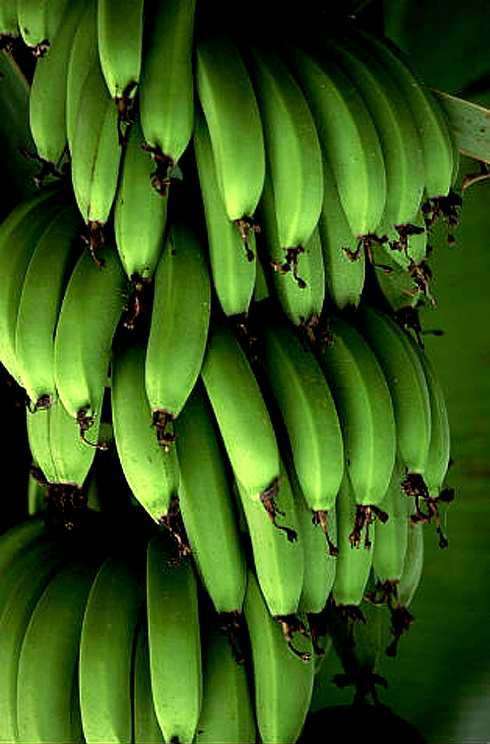
Bananas are thought to be the earth's first fruit. Today they're the favorite fruit.
The earliest recordings of the existence of bananas date to 327 B.C., when Alexander the Great and his army discovered the fruit during their conquest of India.
Bananas first appeared in the United States as early as 1804.
When bananas were introduced to the public at the Philadelphia Centennial Exposition of American Independence in 1876, they sold for 10 cents each. Today they sell for less than 25 cents each in the U.S.
The average Swede consumes 35 pounds (16 kilograms) and the average American eats almost 27 pounds (12.25 kilograms) of bananas annually.
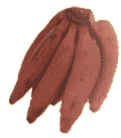 There's
no such thing as a banana tree. A banana plant is a giant perennial
herb, related to lilies, orchids and palms. Its massive leaves can
reach a height of 30 feet (914 centimeters), making the banana the
largest plant on earth without a wooden stem.
There's
no such thing as a banana tree. A banana plant is a giant perennial
herb, related to lilies, orchids and palms. Its massive leaves can
reach a height of 30 feet (914 centimeters), making the banana the
largest plant on earth without a wooden stem.
The Swedish botanist, Linnaeus, gave the banana the Latin name Musa sapientum, which means the fruit of wise men.
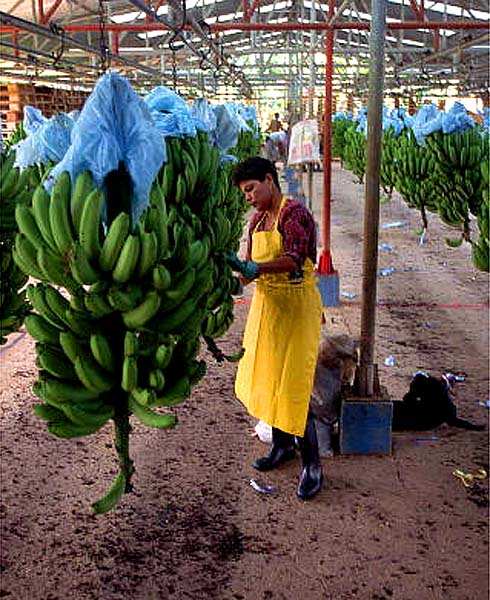 There
are approximately 400 varieties of bananas.
There
are approximately 400 varieties of bananas.
The banana is one of the fruits that ripen best off the plant. They are picked green because they lose their taste and texture if they ripen on the stem.
The inside of a banana peel can be used to polish leather shoes.
Harvested bunches contain an average of 120 - 150 banana fingers each.
It normally takes between 2 and 2 1/2 weeks for the fruit to go from harvest to supermarket shelves.